Quaker Farm
If this site has been helpful to you, please
donate to help support it.
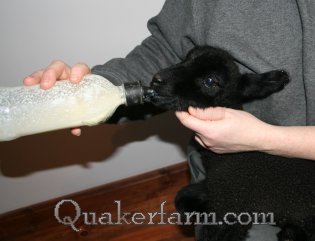 Bottle Feeding and Orphan Lamb PART 2
Instructions for how to bottle feed to lambs (works for goat kids and piglets too!)
Bottle Feeding and Orphan Lamb PART 2
Instructions for how to bottle feed to lambs (works for goat kids and piglets too!)
By Quaker Anne
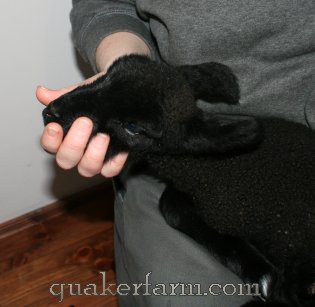 When this is done correctly and for long enough
the lamb will completely relax and then it will be time to introduce the bottle.
When this is done correctly and for long enough
the lamb will completely relax and then it will be time to introduce the bottle.
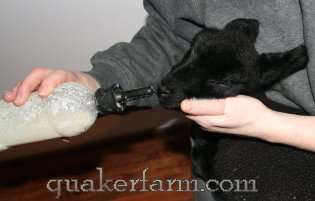 I am right handed, so before introducing the bottle, I make sure the lamb is positioned in the direction my
hands can coordinate
and work together most efficiently which is for me, to have the lamb on my lap facing my right.
I am right handed, so before introducing the bottle, I make sure the lamb is positioned in the direction my
hands can coordinate
and work together most efficiently which is for me, to have the lamb on my lap facing my right.
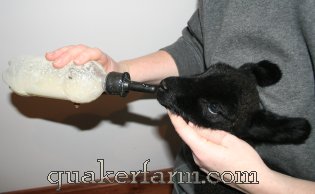 This allows my left hand and arm
to direct his head and firmly restrain his body. My right hand then opens
his mouth to insert the
nipple.
Do note, it is not necessary to have the bottle full to the top of formula. The lamb is only going to eat
a few ounces at a
time at first so it's best to have a smaller more manageable amount.
This allows my left hand and arm
to direct his head and firmly restrain his body. My right hand then opens
his mouth to insert the
nipple.
Do note, it is not necessary to have the bottle full to the top of formula. The lamb is only going to eat
a few ounces at a
time at first so it's best to have a smaller more manageable amount.
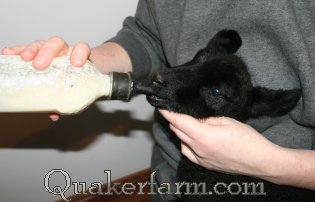 Sometimes, the lamb will take the nipple with little encouragement but most often you will have to be gently persistent and coax him to
take it. Remember, the synthetic
nipple is not as motivating to learn to take nourishment from as his natural mama would have been so
he will likely fight at first to be released from the task. Just be sure to tip forward only a small
amount of fluid at a time so the stream coming out does not overtake and possible choke him and soak you. If he does cough and
sputter through
his initial learning attempts, don't worry, he will be OK - just employ the towel on your lap and try again.
Once he tastes the formula, and if he is hungry enough (which all young ones usually are!), he will begin to latch on and to suck efficiently.
Sometimes, the lamb will take the nipple with little encouragement but most often you will have to be gently persistent and coax him to
take it. Remember, the synthetic
nipple is not as motivating to learn to take nourishment from as his natural mama would have been so
he will likely fight at first to be released from the task. Just be sure to tip forward only a small
amount of fluid at a time so the stream coming out does not overtake and possible choke him and soak you. If he does cough and
sputter through
his initial learning attempts, don't worry, he will be OK - just employ the towel on your lap and try again.
Once he tastes the formula, and if he is hungry enough (which all young ones usually are!), he will begin to latch on and to suck efficiently.
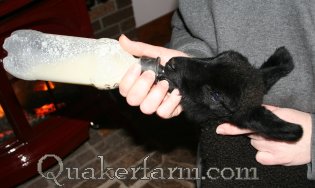 Here you can see that I had to employ the use of my pinkie finger by inserting it into the corner of the lamb's mouth to encourage
him to open it a bit more so I could better insert the nipple. I love working with lambs near the fire - so cozy!
Here you can see that I had to employ the use of my pinkie finger by inserting it into the corner of the lamb's mouth to encourage
him to open it a bit more so I could better insert the nipple. I love working with lambs near the fire - so cozy!
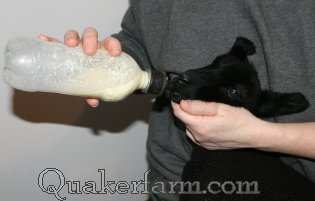 Once a lamb gets the knack of it, he will begin to suck vigorously taking most of the nipple into his mouth. They very often
get a look of startled surprise and enthusiasm for the sudden accomplishment
for being able to nurse and satisfy their hunger!
Once a lamb gets the knack of it, he will begin to suck vigorously taking most of the nipple into his mouth. They very often
get a look of startled surprise and enthusiasm for the sudden accomplishment
for being able to nurse and satisfy their hunger!
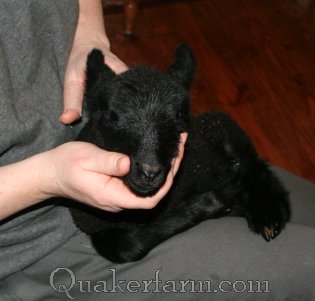
When a newborn lamb finishes feeding, he will be
so satisfied that he will
likely snuggle in with contentment and take a well deserved nap. That was a big lesson to learn and he will be
tired from the effort!
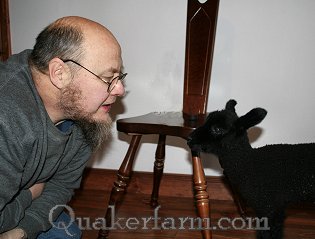
When the baby wakes up, he will soon be ready for another feeding. He will make it clearly known when he is
hungry and needs to eat again. Below is a recommendation for feeding schedule and amounts.
How Much & How Often?
After the initial feeding of colostrum you will want to estimate the use of milk replacer. Infant
lambs should receive at least about 15% to 20% of their body weight in milk replacer daily.
Example: 5 lb lamb X 16oz/lb= 80 oz X 20% = 16 oz daily.
Divide the above daily amount by the number of feedings in a 24-hour period. Increase the amount as the
lamb gains weight and gets older. As you do this, increase the time between feedings.
Feeding Schedule:
For the first 24 hours, give the lamb colostrum every 2 hours
if possible. In the next 24 to 48 hours, gradually
mix the colostrum with lamb milk replacer. By day four,
the lamb should be consuming lamb milk replacer scheduled as recommended below.
Feeding for lambs over 24 hours old:
Day 2 thru 3: every 3 hours
Day 4 thru 7: every 4 hours
Day 8 thru 21: every 6 hours
Day 21 thru 35: every 8 hours
Day 25 till weaning: every 12 hours.
Do not overfeed. A baby will not be able to digest a large volume properly and this will cause scouring.

An artificial lamb nurser can be very helpful if you have more than one lamb to bottle feed,
and if you use the bottle nipples we recommend, the transition should be very easy.
If this site has been helpful to you, please
donate to help support it.
Return to Quaker Farm Home page
|